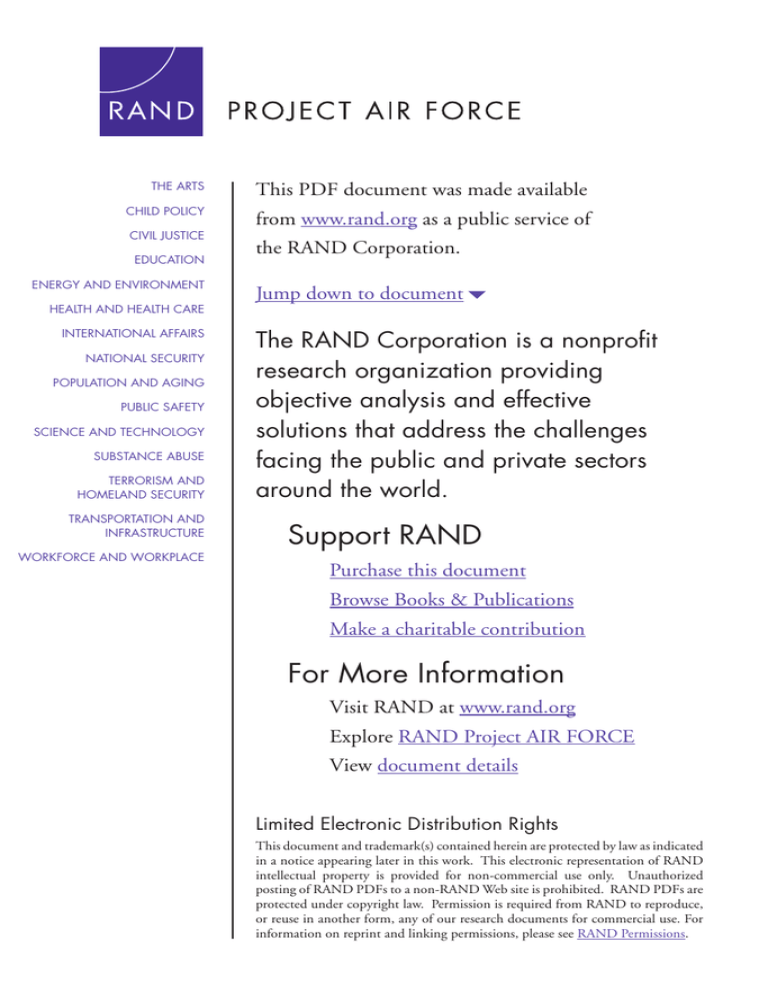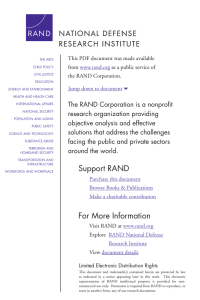
THE ARTS
This PDF document was made available
CHILD POLICY
from www.rand.org as a public service of
CIVIL JUSTICE
EDUCATION
ENERGY AND ENVIRONMENT
HEALTH AND HEALTH CARE
INTERNATIONAL AFFAIRS
NATIONAL SECURITY
POPULATION AND AGING
PUBLIC SAFETY
SCIENCE AND TECHNOLOGY
SUBSTANCE ABUSE
TERRORISM AND
HOMELAND SECURITY
TRANSPORTATION AND
INFRASTRUCTURE
WORKFORCE AND WORKPLACE
the RAND Corporation.
Jump down to document6
The RAND Corporation is a nonprofit
research organization providing
objective analysis and effective
solutions that address the challenges
facing the public and private sectors
around the world.
Support RAND
Purchase this document
Browse Books & Publications
Make a charitable contribution
For More Information
Visit RAND at www.rand.org
Explore RAND Project AIR FORCE
View document details
Limited Electronic Distribution Rights
This document and trademark(s) contained herein are protected by law as indicated
in a notice appearing later in this work. This electronic representation of RAND
intellectual property is provided for non-commercial use only. Unauthorized
posting of RAND PDFs to a non-RAND Web site is prohibited. RAND PDFs are
protected under copyright law. Permission is required from RAND to reproduce,
or reuse in another form, any of our research documents for commercial use. For
information on reprint and linking permissions, please see RAND Permissions.
This product is part of the RAND Corporation monograph series.
RAND monographs present major research findings that address the
challenges facing the public and private sectors. All RAND monographs undergo rigorous peer review to ensure high standards for
research quality and objectivity.
Advancing the
U.S. Air Force’s
Force-Development
Initiative
S. Craig Moore, Marygail K. Brauner
Prepared for the United States Air Force
Approved for public release; distribution unlimited
The research described in this report was sponsored by the United States
Air Force under Contract FA7014-06-C-0001. Further information may
be obtained from the Strategic Planning Division, Directorate of Plans,
Hq USAF.
Library of Congress Cataloging-in-Publication Data
Moore, S. Craig, 1946–
Advancing the U.S. Air Force’s force-development initiative / S. Craig Moore,
Marygail K. Brauner.
p. cm.
Includes bibliographical references.
ISBN-13:
978-0-8330-4012-1
(pbk. : alk. paper)
Library
of Congress
Cataloging-in-Publication
Data is available for this publication.
1. United States. Air Force—Officers. 2. United States. Air Force—Occupational
specialtiesl. 3. United ISBN
States.978-0-8330-4012-1;
Air Force—PersonnelPaperback
management. I. Brauner,
Marygail K., 1947– II. Title.
UG793.M63 2007
358.4'130973—dc22
2007011005
The RAND Corporation is a nonprofit research organization providing
objective analysis and effective solutions that address the challenges
facing the public and private sectors around the world. RAND’s
publications do not necessarily reflect the opinions of its research clients
and sponsors.
R® is a registered trademark.
© Copyright 2007 RAND Corporation
All rights reserved. No part of this book may be reproduced in any
form by any electronic or mechanical means (including photocopying,
recording, or information storage and retrieval) without permission in
writing from RAND.
Published 2007 by the RAND Corporation
1776 Main Street, P.O. Box 2138, Santa Monica, CA 90407-2138
1200 South Hayes Street, Arlington, VA 22202-5050
4570 Fifth Avenue, Suite 600, Pittsburgh, PA 15213-2665
RAND URL: http://www.rand.org
To order RAND documents or to obtain additional information, contact
Distribution Services: Telephone: (310) 451-7002;
Fax: (310) 451-6915; Email: order@rand.org
Summary
A mismatch in the late 1990s between the qualifications needed for
key general officer positions and the available candidates’ backgrounds
stimulated an extensive U.S. Air Force effort to improve the development of senior leaders. The Air Force needed to develop cohorts (individuals who enter the force in a year’s time) of senior officers—generals
and colonels—who have sufficient breadth for their current jobs and for
positions they may need to fill in the future. In the past, most officers
were managed within their career fields and were too narrowly specialized. The intent of our research was to understand the types of skills (or
“competencies”) that each officer position really needs and then to set
targets for the numbers of those who should acquire those skills over
their careers before they are promoted to colonel. The effort evolved
into the current force-development initiative, which is managed by
the Deputy Chief of Staff for Manpower and Personnel; advised by
the FMDC, chaired by the Vice Chief of Staff; and substantially carried out by career-field managers, functional development teams, and
the Air Force Personnel Center’s officer assignment teams. The initiative concentrates first on the development of officers in grades below
colonel. While parallel systems are forming for enlisted and civilian
personnel and the reserve components, our monograph addresses the
system for officers in the active component.
The force-development system should aim to develop enough officers with specified backgrounds so that multiple qualified candidates
will be available for each opening. Beyond the occupational specialties (primary skills) where they substantially “grew up,” most general
xiii
xiv
Advancing the U.S. Air Force’s Force-Development Initiative
officers ideally would have significant experience in a secondary or
paired occupation or skill, preferably with corresponding education or
training. For example, a bomber pilot with a paired skill in international political-military affairs would be regarded as properly qualified for nearly twice as many general officer positions as one lacking
a paired skill. It usually takes deliberate development for an officer to
gain experience outside his or her primary specialty. Subsequent analysis extended the analysis of primary and secondary skills for general
officers and formulated targets for paired skills when officers are promoted to colonel—targets that the development teams began using
during 2005 to guide the mixes of developmental vectors selected for
officers at lower grades in their career fields. For example, at least 5 to
6 percent (but preferably about 12 percent) of new mobility colonels
(“rated” officers who grew up as airlift or tanker pilots or navigators)
would have secondary skills in planning and programming, and about
the same share would have secondary skills in acquisition or financial
management (see p. 18). Factors like job sequencing (e.g., some jobs are
appropriate first jobs for colonels while others require senior colonels),
ill-shaped job pyramids (e.g., some skill pairs are needed for senior jobs
only), and the need for selectivity (multiple qualified candidates should
be available when openings occur) imply that substantially more officers than positions need paired skills. Flow analysis found that, overall, at least 31 percent, and preferably about 58 percent, of new line
colonels should have secondary skills, even though in fiscal year 2002
only 23 percent of about 2,800 line colonel positions needed secondary
skills. Naturally, the targeted secondary skills and percentages differ
across career fields (see p. 16).
A four-step approach can create notably more-specific developmental targets for officers in grades below general officer within a
particular career field: (1) identify and prioritize the types of experience, education, and training that should precede each category of job
(identify the demand, at least for the jobs in the field grades—major,
lieutenant colonel, and colonel), now and in the future; (2) ascertain
the backgrounds that officers have accumulated (assess the supply); (3)
compare supply with demand (gap analysis); and (4) plan ways to close
the gaps. (See pp. 20–26.) We have demonstrated the approach for
Summary
xv
space and missile operations officers (the 13S career field) and are using
it now with (and for) the “rated” (11X [pilot], 12X [navigator], and
13B [air battle manager]) and intelligence (14N) career fields. When
coupled with careful management of officers’ assignments and schooling, the approach promises far more complete fulfillment of positions’
needs and far greater use of officers’ backgrounds than are currently
available (see Figure 4, p. 25).
Key Findings
Multiple Skills Required
Analysis of both general officer and colonel-level (O-6) positions shows
that many positions need pairs of skills—primary and secondary (see
pp. 2–3, 6–7, 11). That is largely why the Air Force instituted the
FMDC and all the associated procedures, to ensure that enough officers get experience in multiple specialties and to counter the tendency
toward overspecialization.
Assessing Skill Requirements
Systematically identifying (and periodically updating) positions’ requirements for both primary and secondary skills is essential. While it may
seem daunting at the outset, it has proven feasible to identify such
requirements and to get them accepted across the Air Force, as RAND’s
work addressing the military and civilian executive forces demonstrates,
for example. We recommend using expert panels rather than surveys of
job incumbents to identify and update most skill requirements, especially for the field grades (see pp. 12, 22).
Important Implications of Multiple-Skill Requirements
Multiple-skill requirements have extensive ramifications, as found
through flow analysis. Even if a minority of positions demands multiple skills, to meet those demands a majority of the officer cohort may
need to have multiple skills. The inventory must include many multiskilled officers, in spite of officers’ natural desire to stay within their
primary specialty in each assignment (see Table 4, p. 16).
xvi
Advancing the U.S. Air Force’s Force-Development Initiative
Keeping Officers on the Right Path
The Air Force needs continuing management to ensure that officers, at
least in the aggregate, are following the right pathways. In particular,
• The Air Force needs agreed-upon mechanisms for tracking skills,
especially to answer the question: How much is enough? This
remains an open question, since originally it was believed that
two tours were needed in a secondary skill, but since then it has
become policy to grant a “developmental [skill] identifier” after
just one year of experience (see p. 9). Having just one year’s experience in an occupational area, perhaps even early in their careers,
probably falls far short of making officers viable candidates for
leadership positions in those areas once they become colonels or
generals.
• The development system needs to manage career fields so that
enough officers have the targeted skill pairs by the time of a
cohort’s promotion to O-6. However, a paired skill should not be
essential for promotion to colonel (see p. 19).
Next Steps
We recommend that the Air Force make its formal instruction about
officer force development (AFI 36-2640) more specific regarding the
need for paired skills at senior levels and regarding the need to systematically plan and manage development for far larger numbers of
midcareer positions. We believe the FMDC and its members should
play important roles in shaping, advocating, coordinating, and monitoring how the functional communities (e.g., operations, intelligence,
logistics, personnel, or acquisition) execute their force-development
responsibilities.
The force-development community should take the following
steps:
• Establish standards for earning paired skills, more demanding
than earning developmental identifiers (see p. 9).
Summary
xvii
• Update and extend the database of backgrounds needed for colonel positions (see p. 12).
• Clarify that earning a paired skill is not essential for promotion
to colonel (see p. 19).
• Set development teams on course to create measurable developmental targets for grades below general officer (see pp. 19–27).
• Create and monitor measures tracking the development of officers promoted to each grade, serving in command jobs, attending
developmental courses in residence, or holding other key assignments (see pp. 27–28).
• Find ways to use or enhance data systems to (1) consistently register jobs’ needs for prior experience, education, and training;
(2) track individual officers’ accumulating portfolios of experience, education, and training; and (3) help recommend and make
assignments whose demands officers meet, that use the officers’
backgrounds, that help manage career fields properly, and that
match members’ preferences insofar as possible (see p. 28–29).
• Improve force planning and management so that career fields’
numerical strengths align more consistently with requirements
and leave room for deliberate professional development (see
p. 29).
Beyond yielding information that the Deputy Chief of Staff for
Manpower and Personnel (AF/A1) and the FMDC can use in deciding resource allocations and making system adjustments, these steps
should help the wide range of force-development players to develop
consistent, efficient, and effective plans and means for improving the
development of officers in their career fields. The steps are also likely to
provide insights and mechanisms that will be valuable more widely as
the Air Force extends and enhances force development to address the
enlisted and civilian forces and the reserve components.






